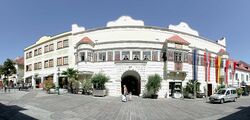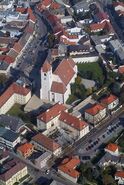| Main | Births etc |
|---|
| Eisenstadt Hungarian: Kismarton, Croatian: Željezni grad, Željezno, Slovene: Železno |
|||
|---|---|---|---|
|
|||
| Coordinates: Coordinates: | |||
| Country | Austria | ||
| State | Burgenland | ||
| District | Statutory City | ||
| Government | |||
| • Mayor | Andrea Fraunschiel (ÖVP) | ||
| Area | |||
| • Total | 42.91 km2 (16.57 sq mi) | ||
| Elevation | 182 m (597 ft) | ||
| Population (1 January 2014)[1] | |||
| • Total | 13,485 | ||
| • Density | 310/km2 (810/sq mi) | ||
| Time zone | CET (UTC+1) | ||
| • Summer (DST) | CEST (UTC+2) | ||
| Postal code | 7000 | ||
| Area code | 02682 | ||
| Vehicle registration | E | ||
| Website | www.eisenstadt.at | ||
Eisenstadt (Hungarian: Kismarton, Croatian: Željezni grad, Željezno, Slovene: Železno) is a city in Austria, the state capital of Burgenland. It has a population of about 13,165 (2012). In the Habsburg monarchy, Kismarton (Eisenstadt) was the seat of the Eszterházy Hungarian noble family. The composer Joseph Haydn lived there as Hofkapellmeister under Esterházy patronage.
Geography[]
Eisenstadt lies on a plain leading down to the river Wulka, at the south foot of the Leitha Mountains, about 12 km from the Hungarian border.

Kleinhöflein im Burgenland at the foot of the Leitha Mountains
Subdivisions[]
Eisenstadt is divided into three districts (Stadtbezirke):
- Eisenstadt-Stadt
- Kleinhöflein im Burgenland (Hungarian: Kishöflány; Croatian: Mala Holovajna) (de) - a town that lies to the west of Eisenstadt proper
- St. Georgen am Leithagebirge (Lajtaszentgyörgy; Svetojurje) (de) - a town that lies to the east of Eisenstadt proper
The city is divided into five Katastralgemeinden:
- Eisenstadt-Stadt
- Oberberg, or Oberberg-Eisenstadt (Hungarian: Felsőkismartonhegy; Croatian: Železno Brig) - the northern area of Eisenstadt from the Jewish quarter, Jewish cemetery
- Unterberg, or Unterberg-Eisenstadt (Alsókismartonhegy; Železno Dolnji Brig) - the southern area of Eisenstadt from Kalvarienbergplatz, Ruster Strasse
- Kleinhöflein im Burgenland
- St. Georgen am Leithagebirge
Other informal areas of the city include Wiesäcker and Lobäcker which lie south of the Eisbach, a tributary of the Wulka. The city is surrounded by the district (Bezirk) of Eisenstadt-Umgebung.
The city previously included the districts (Ortsteile) of Eisenstadt-Stadt, Eisenstadt-Oberberg, Eisenstadt-Unterberg, and Eisenstadt-Schloßgrund (Kismartonváralja).
Origin of the name[]
The present city name, meaning "Iron City", was first recorded in 1118 as "castrum ferrum" and refers to the history of iron mining and iron trade in the area. The first written mention of the town took place in 1264 as "minor Mortin", matching the Hungarian name, Kismarton, which is recalling Saint Martin, the patron saint of the main church.
History[]
Archeological finds prove that the Eisenstadt area was already settled in the Hallstatt period. Celts and Romans settled somewhat later. During the Migration Period, the area was settled by different Germanic tribes and the Huns. Around 800, during the reign of Charlemagne, settlement by the Bavarii began.
The fortress built on the original earth works was destroyed by the troops of Leopold III, Margrave of Austria. In 1241, it was destroyed by the Mongol invaders. In 1373, the town came into the possession of the Kanizsai family, who rebuilt the walls surrounding the town and built a fortress at the site of the present day castle between 1388 and 1392. In 1388, Eisenstadt was given the right to hold markets by Emperor Sigismund.
In 1445 Archduke Albert VI of Austria acquired the town. In 1451 it was ceded to Frederick III, Holy Roman Emperor by Matthias Corvinus in return for the Holy Crown of Hungary. Matthias Corvinus reconquered it by force in 1482, but Maximilian I acquired it again in 1490. It remained under Habsburg rule until 1622. In 1529 and 1532 the Ottoman Empire conquered Eisenstadt with their advance on the city of Vienna (see Ottoman wars in Europe). It was captured by the army of Imre Thököly in 1683, and it saw the defeat of the kuruc army of Sándor Károlyi by the Habsburgs in 1704. A royal town since 1648, it was destroyed by fire in 1589 and 1776.
In 1648, it passed under the rule of the Esterházy family. These Hungarian princes permanently changed the face of the city due to their extensive construction especially on their castle, Schloss Esterházy. The appointment of Joseph Haydn as the prince's Hofkapellmeister (court orchestra director, composing and performing music) began the great artistic period in the city's history. In 1809, Eisenstadt was occupied by French troops during the Napoleonic Wars; in 1897, it was joined to the railway network.
Until the end of World War I, it was the seat of Kismarton district in Sopron county in the Kingdom of Hungary. Without plebiscite, the city and the entire Hungarian territory of Burgenland (with the exception of the city of Sopron where the only plebiscite was held) was transferred to Austria by the Saint-Germain and Treaties of Trianon in 1921. Since 30 April 1925, Eisenstadt is seat of the Burgenland state government and thus the state capital. During World War II, Eisenstadt was heavily bombarded. In 1945, it was occupied by the Red Army, and the city remained until 1955 under Soviet occupation. In 1960, Eisenstadt became the see of its own Roman Catholic diocese.
| Climate chart for Eisenstadt | |||||||||||
|---|---|---|---|---|---|---|---|---|---|---|---|
| J | F | M | A | M | J | J | A | S | O | N | D |
34
3
-3
|
30
5
-2
|
45
10
2
|
52
15
6
|
63
21
10
|
71
23
13
|
67
26
15
|
60
26
15
|
59
21
11
|
44
15
7
|
54
8
2
|
41
4
-1
|
| temperatures in °C • precipitation totals in mm source: ZAMG | |||||||||||
Politics[]
The current mayor of Eisenstadt is Mag. Thomas Steiner ÖVP.
The district council is composed as follows (as of 2007):
- Austrian People's Party (ÖVP): 17 seats
- Social Democratic Party of Austria (SPÖ): 8 seats
- Austrian Green Party: 2 seats
- Freedom Party of Austria (FPÖ): 2 seats
Main sights[]
Castles and palaces[]
- Schloss Esterházy and Schlosspark, the Esterházy castle and park.
- Orangerie
- Lindenstadion
- Gloriette, the former Esterházy hunting lodge.
Religious edifices[]
- Bergkirche, housing Haydn's tomb
- Domkirche, late Gothic former military church, began in 1460
- Franziskanerkirche (Franciscan church), Built in 1629, it contains the crypt of the Esterházy family
- Jewish quarter (German: Judenviertel) of city central (Oberberg)[2]
- Jewish Community of Eisenstadt (1732–1938, 1945-)
- Jerusalemplatz[3] & gate, Judengasse (Unterberggasse)
- Österreichisches Jüdisches Museum and Samnson Wertheimer's house (German: Wertheimer-Haus, the Synagogue of Eisenstadt); there was the chief rabbinate of Hungarian Kingdom: Around Gloriettenallee, Alexander Wolf-Gasse, Meierhofgasse, Museumsgasse, Wertheimergasse, Carl Moreau-Strasse, Alois Tomasini-Gasse, Weingartenstrasse, etc.
- Jewish cemeteries of Eisenstadt

The Old Town Hall
Buildings[]
- Haydn-Mausoleum
- Rathaus (City Hall)
- Pulverturm (lit. "Powder tower")
Museums[]
- Haydnmuseum, a museum dedicated to Joseph Haydn, who lived in the building between 1766 and 1778.
- Landesmuseum (regional museum).
- Österreichisches Jüdisches Museum(Austrian Jewish Museum).[4]
- Diözesanmuseum (museum of the local Roman Catholic diocese).
- Feuerwehrmuseum (fire department museum).
Gallery[]
Culture[]
Eisenstadt hosts a Haydn festival, the Haydnfestspiele.
Twin towns — Sister cities[]
Eisenstadt is twinned with:
Nearby municipalities[]
- Großhöflein, Müllendorf, Steinbrunn, Neufeld/Leitha & Ebenfurth
- Hornstein
- Wulkaprodersdorf, Trausdorf/Wulka (on the Wulka and Eisbach)
Notable citizens[]
Natives[]
- Moritz Benedikt (1835–1920) neurologist
- Isaiah Berlin (1725–1799) rabbi
- Stefan Billes (1909, Kleinhöflein – 2002) politician
- Akiva Eiger (1761–1837) rabbi and champion of Orthodox Judaism
- Paul I, 1st Prince Esterházy of Galántha
- Prince Paul II Anton Esterházy (1711–1762) soldier and patron of music
- Gyula Farkas (1894–1958) linguist
- Andrea Fraunschiel (1955 – ) mayor
- Josef Hyrtl (1810–1894) anatomist
- Andreas Ivanschitz (1983 – ) football player, lived in Baumgarten, about 12 km from Eisenstadt
- Josef Kirchknopf (1930, Kleinhöflein – ), politician
- Johann Luif (1959, Kleinhöflein – ), BG, Commander Provincial Military Headquarters Burgenland
- Maria Perschy (1938–2004, Vienna) actress
- Rudolf Simek (1954 – ) Germanist and Philologian.
- Martin Vukovich (1944 – ) diplomat
- Joseph Franz Weigl (1740–1820) cellist
- Joseph Weigl (1766–1846) composer and conductor
- Anton Pauschenwein (1981 – ) football player
- Thomas Mandl (1979 – ) football player
- Michael Mörz (1980 – ) football player
- Johann Dihanich (1958 – ) football player
Other residents[]
- Samuel Löw Brill (1814–1897), rabbi and Talmudical scholar; born in Budapest; attended yeshiva
- Meir Eisenstadt (1670–1744) rabbi of the Siebengemeinden
- Joseph Haydn (1732–1809), musician, born in Rohrau
- Azriel Hildesheimer (1820–1899), German rabbi, founder of Torah im Derech Eretz; in 1851, he was called to the rabbinate of Eisenstadt
- Markus Horovitz (1844–1915), German rabbi and historian; born March 14, 1844, in Tiszaladány, Hungary, pursued his rabbinical studies at the yeshiva
- Johann Nepomuk Hummel (1778–1837), musician
- Adam Liszt (1776–1827), musician, father of Franz Liszt
- Leopold Löw (1811–1875), born in Černá Hora, Moravia, studied at the yeshiva of Eisenstadt
- Mordecai Mokiach (ca. 1650–1724), "pseudo"-Messiah, born in Alsace
- Robert Musil (1880–1942), author
- Ignaz Pleyel (1757–1831), composer
- Emanuel Schreiber (1852–1932), rabbi
- Fritz Spiegl (1926–2003) musician, journalist, broadcaster, humorist and collector
- Isaac Hirsch Weiss (1815–1905), talmudist and historian of literature; born at Velké Meziříčí, Moravia; studied at yeshiva
- Samson Wertheimer (1658–1724), rabbi
- Aaron Wise (1844–1896), rabbi, born in Eger, Hungary, studied at yeshiva; the father of Stephen Samuel Wise
As a surname[]
Eisenstadt (also Ajzenstat, Eisenstaedter, Asch, etc.), a Jewish surname, derives from this city. Some people with this surname or its variants include:
- Alfred Eisenstaedt
- Meir Eisenstadt
- Shmuel Eisenstadt Israeli sociologist
- Stuart E. Eizenstat
- Moses Asch
References[]
- ^ Statistik Austria - Bevölkerung zu Jahres- und Quartalsanfang, 2014-01-01.
- ^ [1], [2]
- ^ [3]
- ^ "Schalom" (in German). Österreichisches Jüdisches Museum. http://www.ojm.at/. Retrieved 2008-04-26.
External links[]
- Official site (German)
- Official Eisenstadt Tourism Site
- Eisenstadt on the official Burgenland site (German)
- Österreichisches Jüdisches Museum (Austrian Jewish Museum) (German)
- Jewish Encyclopedia article on the Jewish community of Eisenstadt (English)
- Schloss Esterházy (Esterházy Castle) (German)
- Haydn festival (German) (English)
- Fachhochschul-Studiengänge Burgenland University of applied sciences. (German)
- "Iron City", Eisenstadt page for young adult activities. (German)
- Eisenstadt in English (English)
| ||||||||||
| |||||||||







